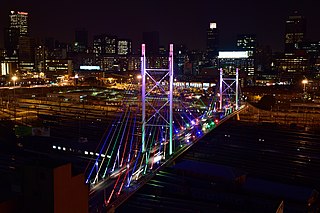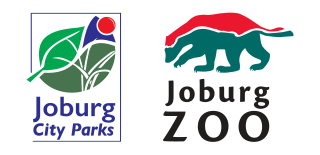
Johannesburg is the most populous city in South Africa with 4,803,262 people, and is classified as a megacity; it is one of the 100 largest urban areas in the world. It is the provincial capital of Gauteng, the wealthiest province in South Africa. Johannesburg is the seat of the Constitutional Court, the highest court in South Africa. Most of the major South African companies and banks have their head offices in Johannesburg. The city is located within the mineral-rich Witwatersrand hills, the epicentre of the international-scale mineral, gold and (specifically) diamond trade.

Gauteng is one of the nine provinces of South Africa.

The Witwatersrand Gold Rush was a gold rush that began in 1886 and led to the establishment of Johannesburg, South Africa. It was a part of the Mineral Revolution.

Roodepoort is a city in the Gauteng province of South Africa. Formerly an independent municipality, Roodepoort became part of the Johannesburg municipality in the late 1990s, along with Randburg and Sandton. Johannesburg's most famous botanical garden, Witwatersrand National Botanical Gardens, is located in Roodepoort.
Constantia Kloof is a suburb of Roodepoort in Gauteng, South Africa. It borders the suburbs of Strubens Valley, Weltevreden Park, Helderkruin and Allen's Nek, and is considered one of the more scenic and upmarket suburbs in the Western Johannesburg, especially within its boom-controlled area. Some of the best views over Johannesburg can be seen from the Constantia Kloof houses and apartments along Constantia Drive and Panorama Drive. The area has become very popular since the opening of the Clearwater Mall.
Dobsonville is a township in greater Soweto, Johannesburg, South Africa. It lies to the west of Meadowlands, a part of Diepmeadow, and is adjacent to Mofolo North and Zondi, which are suburbs of Soweto on its southern border.

Randfontein is a gold mining town in the West Rand, Gauteng, South Africa, 40 km (25 mi) west of Johannesburg. With the Witwatersrand gold rush in full swing, mining financier JB Robinson bought the farm Randfontein and, in 1889, floated the Randfontein Estates Gold Mining Company. The town was established in 1890 to serve the new mine and was administered by Krugersdorp until it became a municipality in 1929. Apart from having the largest stamp mill in the world, Randfontein, like many of the other outlying areas of Johannesburg, is essentially a rural collection of farms and small holdings in a particularly beautiful part of Gauteng.
Ferreirasdorp is an inner-city suburb of Johannesburg, South Africa located in Region F of the City of Johannesburg Metropolitan Municipality.

Harmony Gold is the largest gold mining company in South Africa. Harmony operates in South Africa and in Papua New Guinea. The company has nine underground mines, one open-pit mine and several surface operations in South Africa. In Papua New Guinea, it has Hidden Valley, an open-pit gold and silver mine and a 50% interest in the Morobe Mining Joint Venture, which includes the Wafi-Golpu project and extensive exploration tenements. Outside the joint venture, Harmony's own exploration portfolio focuses principally on highly prospective areas in Papua New Guinea.

The Walter Sisulu National Botanical Garden, previously known as the Witwatersrand National Botanical Garden, is a 300 hectares (3.0 km2) botanical reserve in western Roodepoort near Johannesburg. It was formally established in 1982 as the Transvaal National Botanic Gardens, at which time it was the 14th of South Africa's National Botanical Gardens. It was opened to the public in 1987 as the Witwatersrand National Botanical Gardens, on the occasion of the handing over of some 120 ha of farm Roodekrans by the Krugersdorp Town Council for inclusion in the reserve.

Johannesburg City Parks and Zoo (JCPZ) is a not-for-gain company established under Section 21 of the South African Companies Act and wholly owned by the City of Johannesburg.
The Minerals Council South Africa is a South African mining-industry employer organisation. Its members include famous South African mining houses such as Anglo American, De Beers, Gold Fields and Harmony. In its current form, it was founded in 1968 as the Chamber of Mines, a South African wide organization. Prior to that year, it has its early origins as the Transvaal Chamber of Mines in 1887, then evolved over many years reforming as the Witwatersrand Chamber of Mines in 1889, the Chamber of Mines of the South African Republic from 1897, Transvaal Chamber of Mines from 1902 and lastly from 1953 until 1967 as the Transvaal and Orange Free State Chamber of Mines. On 23 May 2018, the South African Chamber of Mines rebranded themselves as the Minerals Council South Africa.
The R564 is a Regional Route in the City of Johannesburg Metropolitan Municipality in Gauteng, South Africa. It connects Roodepoort with Buccleuch via Northriding and Fourways.

Simmer and Jack Mines Ltd is a South African company which was founded in 1887 by the German August Simmer and Scotsman John Jack, shortly thereafter selling the majority shareholding to Gold Fields of South Africa Ltd. The company was listed until 2013 at the Johannesburg Stock Exchange.

Harry Struben, born Hendrik Wilhelm Struben and also known as Henry William Struben, was a South African randlord. He was the brother of Frederick Struben; together they managed the first gold-mining operation on the Reef. They were the sons of Johan Marinus Struben, a South African Republic official, and his wife Frances Sarah Beattie of Scottish origin. Harry was born during a yacht trip along the Lower Rhine. His family emigrated to Pietermaritzburg in Natal in 1850, and moved to Pretoria five years after.

Spitchwick is an historic estate situated within the parish of Widecombe-in-the-Moor, Devon. The present 19th century mansion house known as Spitchwick Manor is situated four miles north-west of Ashburton, the gardens of which are open to the paying public.

Edith Frances Mary Struben was a South African botanical illustrator and painter. She was the eldest daughter of Harry Struben, a pioneer gold miner on the Witwatersrand.

Westdene is a suburb of Johannesburg, South Africa. Westdene lies between the historic suburb of Sophiatown and Melville with the Melville Koppies nature reserve to the north of the suburb. Westdene derives its name from its location, literally meaning west-valley. 'West' since it is located west from the city centre and with 'dene' derived from the Old English denu, meaning valley.
The M47 is a short metropolitan route in Roodepoort, South Africa. It connects the N14 at Cradlestone Mall with the M18 at Maraisburg in Roodepoort. It consists of only one street, named Hendrik Potgieter Road.

Confidence Reef is a historical gold-bearing quartz vein situated within the Kloofendal Nature Reserve, in close proximity to Roodepoort, South Africa.















